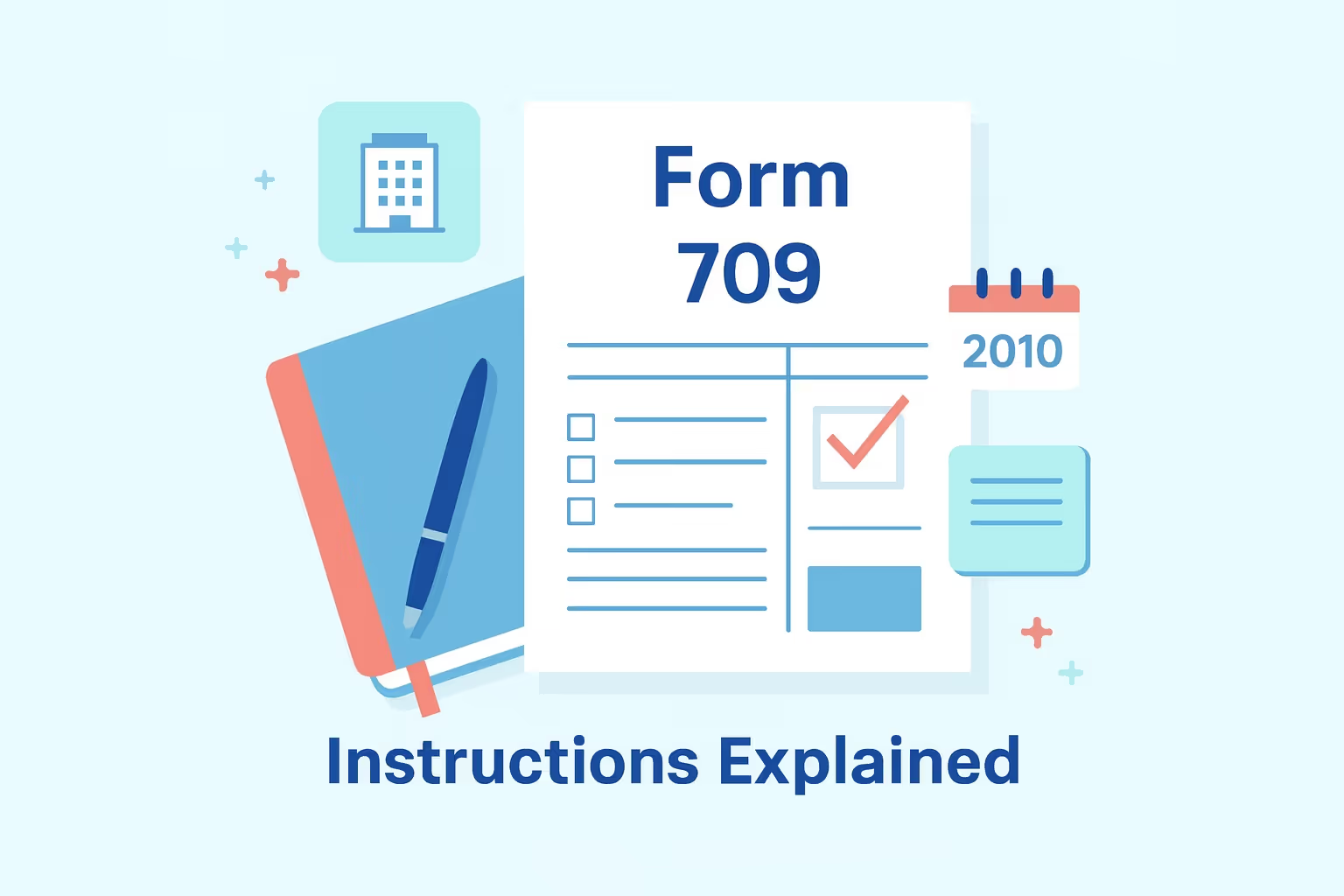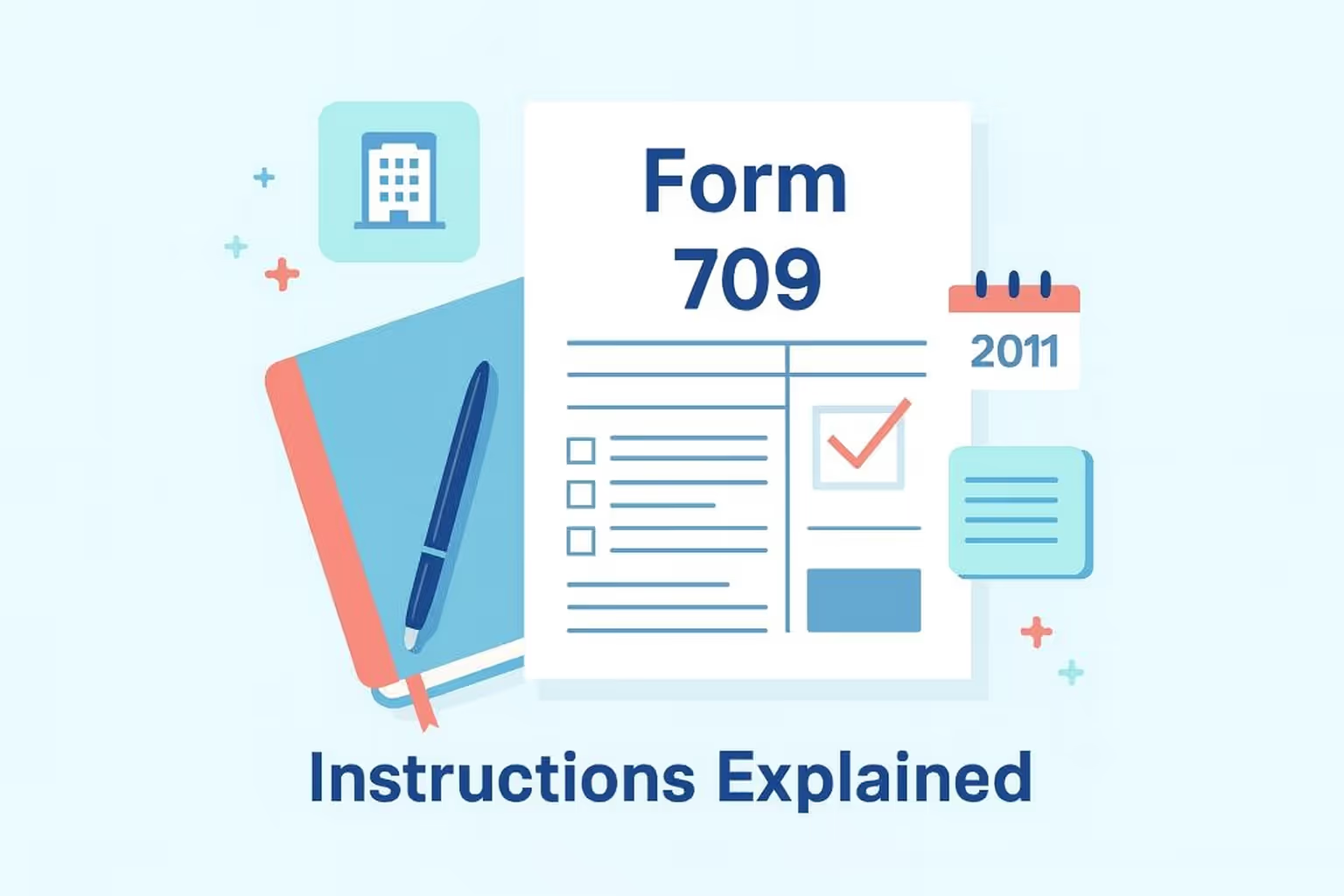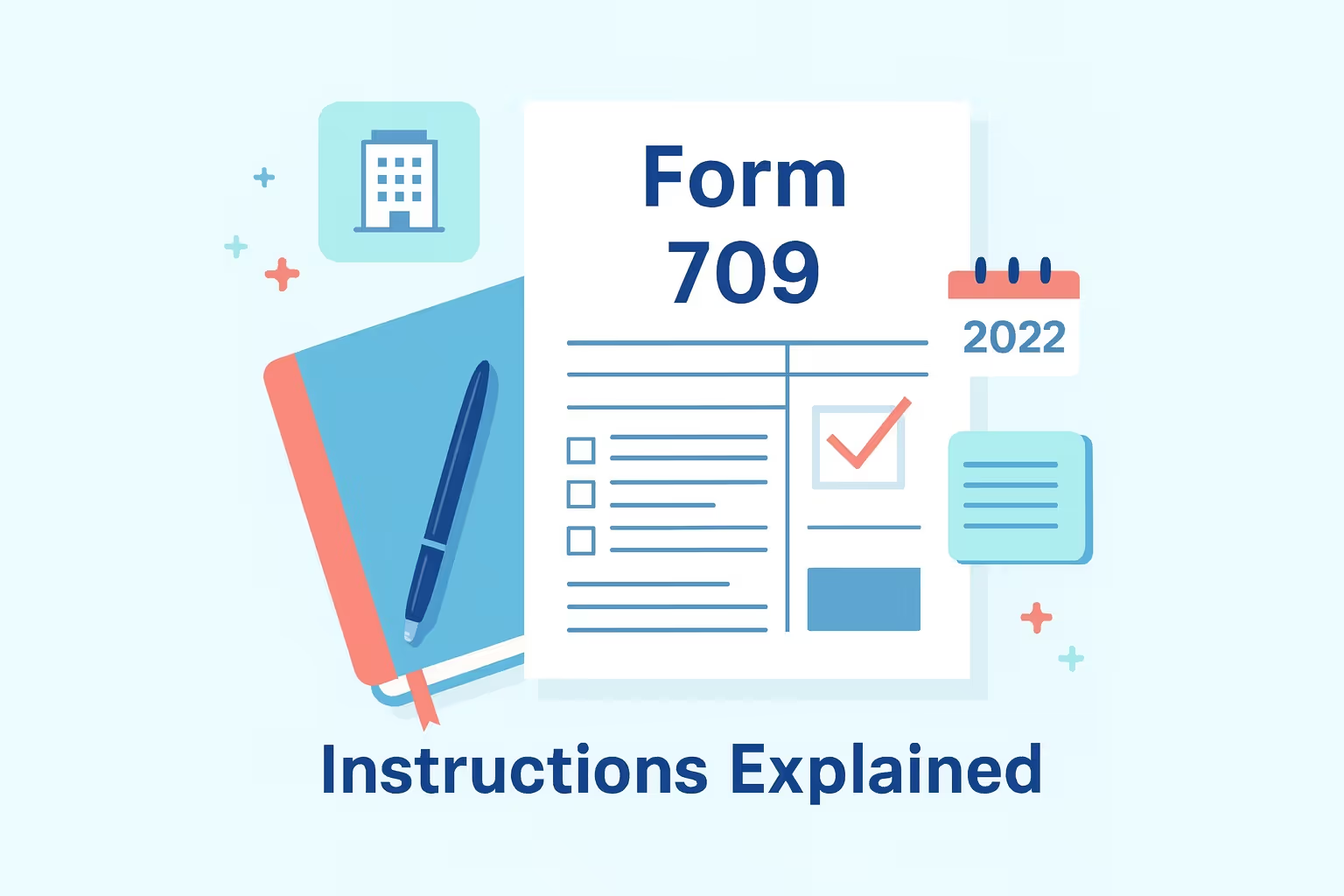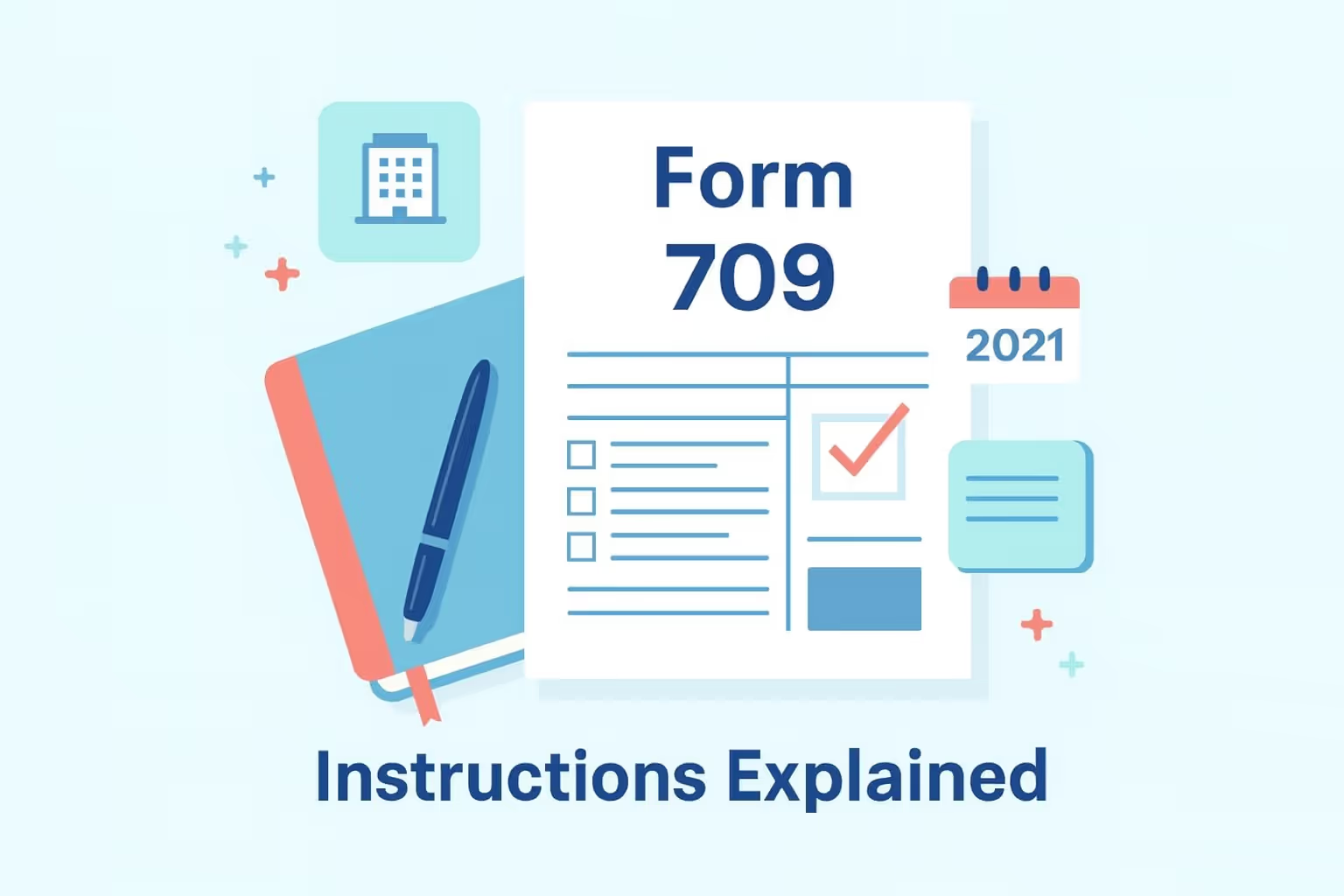Instrucciones del formulario 709 2020: Guía de presentación de declaraciones de impuestos sobre donaciones
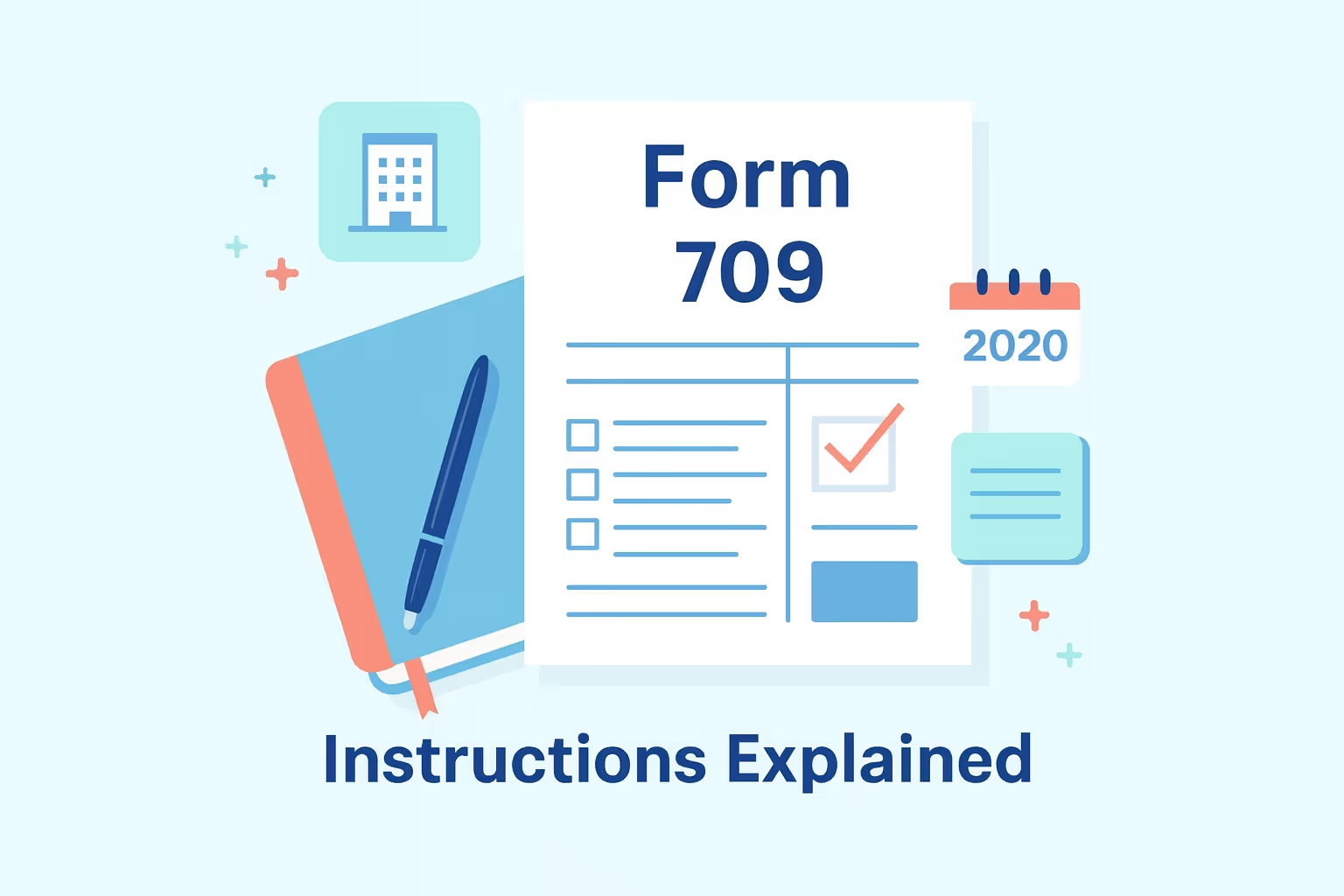
Presentar el formulario 709 para el año tributario 2020 es esencial para cualquier persona que haya realizado donaciones financieras importantes durante ese año. El formulario, oficialmente denominado Declaración de impuestos sobre donaciones (y transferencias generacionales) de los Estados Unidos, se utiliza para declarar las donaciones sujetas a impuestos y hacer un seguimiento del uso de la exención del impuesto sobre donaciones y sucesiones de por vida de una persona. También ayuda al Servicio de Impuestos Internos (IRS) a controlar las transferencias que pueden afectar las futuras obligaciones tributarias sobre el patrimonio.
Debe presentar el formulario 709 si donó más de 15 000 dólares a una persona en 2020, excluyendo los obsequios a un cónyuge ciudadano estadounidense. Lo mismo se aplica si en el futuro hizo donaciones con intereses, transferencias generacionales o obsequios de más de 157 000 dólares a un cónyuge no ciudadano. Incluso si no adeuda ningún impuesto federal sobre donaciones, es necesario presentar la declaración para registrar el monto aplicado a su exención vitalicia. La presentación adecuada también evita discrepancias futuras al calcular los totales del patrimonio o de las exenciones.
Debido a que la presentación electrónica no estaba disponible en 2020, todas las declaraciones del formulario 709 deben imprimirse, firmarse y enviarse por correo al Centro de Servicio del IRS. La mayoría de los contribuyentes no adeudarán impuestos sobre donaciones debido a la exención vitalicia de 11,58 millones de dólares, pero es esencial que los informes sean precisos. Las siguientes secciones proporcionan instrucciones completas sobre el formulario 709 2020 y ofrecen una guía clara y paso a paso para las personas que presentan una declaración federal de impuestos sobre donaciones por primera vez.
Comprensión del formulario federal 709
El formulario 709, también conocido como declaración de impuestos sobre donaciones (y transferencias generacionales) de los Estados Unidos, informa sobre las transferencias de dinero o propiedad que pueden estar sujetas a impuestos por el Servicio de Impuestos Internos (IRS). Permite a los contribuyentes y al IRS documentar las donaciones importantes y confirmar el cumplimiento de las normas federales de presentación de informes.
Sus objetivos principales incluyen:
- Reportar donaciones que superen el límite anual: Obligatorio cuando el total de obsequios a un destinatario supera la exclusión anual de 15 000$ para 2020.
- Seguimiento del uso de la exención de por vida: Mantiene un registro de la cantidad de 11,58 millones de dólares de exención de impuestos sobre donaciones y sucesiones de por vida que se ha aplicado.
- Grabación de transferencias generacionales: Cubre las transferencias realizadas a nietos u otras personas que estén más de una generación por debajo del donante.
- Respaldando la revisión del IRS: Mantiene un registro oficial de las transferencias imponibles y exentas para garantizar la precisión de los informes a lo largo del tiempo.
La presentación del formulario 709 no necesariamente resulta en la deudación de impuestos. Por lo general, documenta las donaciones declarables y rastrea los montos de exención restantes para futuras consideraciones patrimoniales.
¿Quién debe presentar el formulario 709?
La presentación es obligatoria para el año tributario 2020 en las siguientes circunstancias:
Cuando se requiere la presentación:
- Los obsequios que superaban los 15 000 dólares se entregaron a un solo destinatario (que no fuera un cónyuge ciudadano de los EE. UU.).
- Las transferencias implicaban intereses futuros, por lo que los destinatarios no podían acceder a la propiedad de inmediato.
- Un cónyuge no ciudadano recibió obsequios por un total de más de 157.000 dólares.
- Se hizo una transferencia generacional a nietos u otros beneficiarios de generaciones inferiores.
Cuando no se requiere la presentación:
- Todos los obsequios permanecieron dentro del monto de exclusión anual.
- Los pagos de matrícula se hicieron directamente a las instituciones educativas.
- Los pagos fueron directamente a los proveedores médicos para cubrir los costos de atención médica.
- Se hicieron donaciones a organizaciones benéficas u organizaciones políticas calificadas.
Para obtener una guía oficial completa, visite la Formulario 709 del IRS Instrucciones para 2020. Comprender estas distinciones ayuda a determinar qué transferencias son declarables y garantiza que todas las donaciones aplicables se documenten correctamente en las normas fiscales federales sobre donaciones.
Actualizaciones del impuesto sobre donaciones de 2020 y umbrales clave
El año tributario de 2020 incluyó varios límites y cifras críticos para calcular las posibles obligaciones del impuesto federal sobre donaciones y transferencias generacionales (GST). Estos límites ayudan a determinar si es obligatorio presentar el formulario 709 y qué parte de la exención de por vida se puede aplicar a las donaciones declaradas.
Límites clave del impuesto sobre donaciones para 2020:
- Exclusión anual: 15 000$ por destinatario. Por lo general, no es necesario archivar los obsequios por debajo de esta cantidad.
- Exclusión de cónyuges no ciudadanos: 157.000 dólares. Las transferencias de hasta este importe se excluyen de la declaración de impuestos sobre donaciones.
- Exención de impuestos sobre donaciones y sucesiones de por vida: 11.580.000 dólares. Este total cubre todas las donaciones imponibles hechas durante la vida y el valor de un patrimonio al fallecer.
- Tasa máxima de impuestos sobre regalos: 40% en transferencias imponibles que superen la exención disponible.
Los detalles adicionales del año incluyen:
- La presentación electrónica del formulario 709 no estaba disponible en 2020. Todas las declaraciones deben imprimirse, firmarse y enviarse por correo al Servicio de Impuestos Internos (IRS).
- La tasa impositiva sobre transferencias generacionales también se mantuvo en el 40%, igualando la tasa impositiva sobre donaciones.
- Las normas de portabilidad permitían a los cónyuges supervivientes utilizar cualquier parte no utilizada de la exención del cónyuge fallecido, declarada a través de la Exclusión no utilizada del cónyuge fallecido (DSUE).
Conocer estas cifras ayuda a garantizar la precisión de los informes y evita la presentación de documentos innecesarios. Llevar un registro de los límites anuales y vitalicios también es esencial para planificar a largo plazo los impuestos sobre sucesiones y donaciones.
Instrucciones paso a paso para presentar el formulario 709
Estas instrucciones del formulario 709 2020 explican cómo preparar, completar y presentar correctamente su declaración federal de impuestos sobre donaciones. Seguir estos pasos ayuda a garantizar el cumplimiento con el Servicio de Impuestos Internos (IRS) y reduce el riesgo de errores en la presentación. Revise las instrucciones del IRS para Formulario 709 (2020) para una referencia completa.
Paso 1: Reunir documentación
Antes de comenzar, reúna toda la información necesaria para completar el formulario con precisión.
- Recopile detalles sobre cada donación, incluida la fecha, la descripción, el valor justo de mercado y la base ajustada por el donante.
- Haz una lista con el nombre, la dirección y la relación de cada destinatario con el donante.
- Incluya los formularios 709 anteriores, que son necesarios para completar el Anexo B para las conciliaciones del año anterior.
- Organice los documentos de respaldo, como tasaciones, instrumentos fiduciarios o acuerdos comerciales que verifiquen el valor de los obsequios.
Tener estos materiales listos facilita completar el formulario y confirma que todas las donaciones declarables están debidamente documentadas.
Paso 2: Complete la parte 1: Información general
La parte 1 del formulario 709 recopila los detalles de identificación y determina si se aplican reglas especiales. Introduzca el nombre, el número de seguro social, la dirección y el estado de ciudadanía del declarante. Indique si se presentaron declaraciones de impuestos sobre donaciones anteriores o si se concedió una prórroga.
Si una pareja casada decide dividir los regalos, marque la casilla para dividir los obsequios, anote la información del cónyuge y obtenga una firma de consentimiento. Por último, confirme que el número total de donatarios que figura en esta sección coincide con el total registrado en el anexo A. La precisión de esta sección garantiza la coherencia de la información durante toda la declaración.
Paso 3: Complete el Anexo A: Cálculo de las donaciones sujetas a impuestos
El Anexo A es el núcleo del proceso de presentación. Enumera todas las donaciones declarables realizadas durante 2020.
- Registra cada obsequio por separado con la información del destinatario, la relación, la fecha de la transferencia y el valor justo de mercado en la fecha del regalo.
- Identifique si la donación es un interés presente o futuro; solo los intereses actuales califican para la exclusión anual de 15 000$.
- Deduzca las contribuciones caritativas o matrimoniales cuando corresponda y sume todas las donaciones imponibles en la Parte 4.
- Para los regalos divididos, introduce la mitad del valor del obsequio en la columna designada.
Incluya una nota breve que describa cómo se valoraron los activos no monetarios, como los intereses inmobiliarios o comerciales. En esta sección se determina la parte imponible de tus transferencias y qué parte de la exención de por vida se utiliza.
Paso 4: Complete la parte 2: Cálculo de impuestos
Después de determinar los montos imponibles del Anexo A:
- Agregue los obsequios sujetos a impuestos anteriores que figuran en el Anexo B.
- Calcule el impuesto provisional sobre el total de todos los obsequios utilizando la tabla de impuestos del IRS.
- Reste los impuestos pagados anteriormente por las donaciones de años anteriores.
- Aplica el crédito unificado de 2020 para reducir o eliminar el saldo adeudado.
Este proceso determina si se adeuda un impuesto adicional sobre donaciones o si hay un sobrepago que transferir.
Paso 5: adjunte los cronogramas, revise y prepárese para el envío
Adjunte todos los cronogramas y documentos requeridos antes de enviar su declaración. Esto incluye:
- Programa B: Se aplicaron obsequios y créditos sujetos a impuestos del año anterior.
- Programa C: Exclusión no utilizada por cónyuge fallecido (DSUE), si corresponde.
- Programa D: Cálculo de impuestos de transferencias generacionales (GST).
Firma y fecha en la devolución, adjunta el pago si es necesario y revisa todas las entradas para comprobar que son coherentes. Asegúrese de que el valor de cada obsequio refleje la fecha real de la transferencia, no las estimaciones de fin de año. Una revisión final de los totales y los archivos adjuntos confirma que la declaración de impuestos sobre donaciones del formulario 709 de 2020 es exacta y está completa antes de enviarla por correo al IRS.
Cómo presentar el formulario federal 709
La presentación del formulario 709 para el año tributario 2020 requiere una preparación y presentación cuidadosas para garantizar que el Servicio de Impuestos Internos (IRS) reciba una declaración completa y precisa. Como la presentación electrónica no está disponible este año, todas las declaraciones deben enviarse por correo. Comprender dónde y cómo enviar el formulario, y qué plazos se aplican, es esencial para el cumplimiento.
Presentación en papel solo para 2020
El IRS no ofreció la presentación electrónica del formulario 709 en 2020. Cada declaración debe imprimirse, firmarse y enviarse por correo con el pago o los archivos adjuntos requeridos. La dirección postal depende del método de entrega:
- Correo regular:
Departamento del Tesoro
Centro de Servicio de Impuestos Internos
Kansas City, MO 64999 - Servicio de entrega privada (PDS):
Servicio de Impuestos Internos
333 W. Pershing Road
Kansas City, MO 64108
Si utiliza un servicio de entrega privado, confirme que aparezca en la lista aprobada por el IRS para «enviar a tiempo como presentación oportuna». Esta lista está disponible en el sitio web del IRS y garantiza que se respeten las fechas de entrega en los plazos de presentación.
Plazos y extensiones de presentación
La fecha límite normal para presentar el formulario 709 de 2020 era el 15 de abril de 2021, y cubre las donaciones realizadas entre el 1 de enero y el 31 de diciembre de 2020. Las personas que no pudieran cumplir con la fecha límite original podían solicitar una prórroga automática de seis meses utilizando:
- Formulario 4868: Solicitud de prórroga automática para presentar la declaración de impuestos sobre la renta individual de EE. UU.
- Formulario 8892: Solicitud de prórroga automática para presentar la declaración de impuestos sobre donaciones (y transferencias generacionales).
Incluso con una prórroga aprobada, cualquier pago adeudado debe hacerse antes del 15 de abril para evitar multas o intereses. Se aplica el siguiente día hábil si la fecha de vencimiento coincide con un fin de semana o un feriado federal.
Antes de enviarlo por correo, revise todos los cronogramas, adjunte el pago si es necesario y guarde una copia firmada para su registro. El uso de correo certificado o de un servicio de mensajería aprobado constituye una prueba de la presentación puntual y garantiza el cumplimiento de las normas de presentación del IRS para el año tributario 2020.
Información sobre pagos y multas
Comprender cómo funcionan los pagos y las multas según el formulario 709 ayuda a mantener el cumplimiento y evitar errores costosos. La mayoría de los contribuyentes no adeudan impuestos sobre donaciones, pero aun así es necesario determinar si existe una obligación tributaria sobre donaciones antes de presentar la declaración.
Cuándo se requiere el pago
El impuesto sobre donaciones se aplica solo si el valor total de las donaciones sujetas a impuestos supera la exención del impuesto sobre donaciones de por vida, que fue de 11,58 millones de dólares en 2020. Por lo general, las donaciones que reúnen los requisitos para la exclusión fiscal anual de 15 000$ por destinatario no reducen la exención.
Es posible que las transferencias que impliquen solo un interés parcial, en las que el donante retenga algún beneficio o control, no reúnan los requisitos para la exclusión del impuesto sobre donaciones y deben revisarse cuidadosamente. Estas reglas se aplican específicamente a los fines del impuesto sobre donaciones y son independientes de las obligaciones tributarias federales sobre la renta.
Opciones de pago
Los pagos se pueden realizar mediante:
- Cheque o giro postal: A nombre del «Tesoro de los Estados Unidos», con el «Formulario 709» y el año tributario en la línea de notas.
- Sistema electrónico de pago de impuestos federales (EFTPS): Recomendado para pagos más rápidos y rastreables.
Incluso con una extensión aprobada, el pago vence antes del 15 de abril de 2021 para evitar multas.
Multas e intereses
La presentación o el pago tardíos pueden resultar en multas de hasta el 25% del impuesto adeudado, con intereses diarios agregados hasta que se reciba el pago completo. Presentar una declaración de impuestos completa y puntual sobre donaciones ayuda a preservar los registros vitalicios y a prevenir problemas futuros relacionados con los impuestos sobre donaciones y el GST.
Cronogramas y anexos requeridos
Presentar el formulario 709 con precisión implica más que completar el formulario principal; también requiere adjuntar los anexos y los documentos de respaldo correctos. Cada lista tiene un propósito específico: garantizar que todos los destinatarios de los regalos, las transferencias y los montos de las exenciones se declaren adecuadamente durante el año calendario.
Anexo A — Cálculo de donaciones sujetas a impuestos
El Anexo A enumera todas las donaciones declarables hechas durante el año. Cada entrada debe incluir el nombre del destinatario, la dirección, la relación con el donante y una descripción completa de la donación. No es necesario que figuren en la lista los obsequios que reúnen los requisitos para estar exentos de impuestos, como los pagos directos de gastos médicos o de matrícula a los proveedores.
Sin embargo, ciertos obsequios, como los intereses futuros, siempre deben declararse porque no están disponibles de inmediato para el destinatario y no pueden usarse como parte de la exclusión anual.
Anexo B — Obsequios de períodos anteriores
El Anexo B registra las donaciones sujetas a impuestos declaradas en años anteriores. Ayuda al IRS a rastrear qué parte de la exclusión vitalicia ya se ha utilizado. Guarde copias de los formularios 709 anteriores para asegurarse de que estas cantidades se mantengan consistentes.
Anexo C: Exclusión no utilizada del cónyuge fallecido (DSUE)
Cuando uno de los cónyuges fallece, el sobreviviente puede usar la exención de impuestos sobre donaciones y sucesiones no utilizada del fallecido. Esta sección se aplica cuando los cónyuges presentan las declaraciones de impuestos sobre donaciones por separado en lugar de presentar una declaración conjunta de impuestos sobre donaciones. Adjunte la documentación justificativa, como el formulario 706 del cónyuge, para solicitar este beneficio.
Anexo D — Impuesto sobre transferencias generacionales (GST)
Este cronograma informa sobre las transferencias a nietos u otras personas que no lo hacen. Incluya detalles sobre la propiedad, los instrumentos fiduciarios y las asignaciones de exenciones.
Antes de enviarlos por correo, adjunte las tasaciones, los documentos del fideicomiso u otros documentos legales que respalden las valoraciones de los obsequios. Si paga impuestos sobre donaciones o paga impuestos con su declaración, incluya un cheque o comprobante de pago. Presenta siempre una declaración de impuestos sobre donaciones antes de la fecha límite; si la fecha de vencimiento coincide con un feriado legal, se extiende automáticamente al siguiente día hábil.
Las personas que hacen regalos y completan correctamente estas listas se aseguran de que todos sus intereses en cada transferencia estén debidamente documentados para el IRS y mantienen un registro preciso de las donaciones caritativas a organizaciones exentas específicas y las donaciones filantrópicas para referencia futura.
Errores comunes que se deben evitar
Evitar errores frecuentes al presentar el formulario 709 ayuda a garantizar un procesamiento oportuno y un mantenimiento de registros preciso. A continuación se detallan los errores clave a los que hay que prestar atención y cómo corregirlos.
- Declaración de transferencias no sujetas a impuestos: Algunos declarantes incluyen por error solo obsequios que no cumplen con los requisitos de presentación de informes. Los pagos directos a una organización educativa en concepto de matrícula o proveedores médicos están excluidos y no deben figurar en el formulario. Informar estos datos de forma errónea puede causar confusión o generar totales inexactos.
- Informe conyugal incorrecto: Los obsequios a su cónyuge, ciudadano de los EE. UU., son generalmente ilimitados y no es necesario presentarlos. Sin embargo, los obsequios a un cónyuge que no sea ciudadano tienen un límite anual independiente que debe respetarse. Confirme siempre la exclusión correcta antes de denunciar las transferencias matrimoniales.
- Información incompleta o faltante: Omitir los detalles del donante, las direcciones de los destinatarios o el valor de los obsequios a menudo lleva a que el IRS los rechace. Asegúrese de que cada sección esté completa y firmada. Una persona soltera debe dejar en blanco las secciones conyugales, mientras que las personas casadas deben presentar una declaración por separado, a menos que se apliquen reglas conjuntas específicas.
- Presentación tardía o plazos incumplidos: El incumplimiento de los plazos, incluso si no se adeuda ningún impuesto, puede resultar en multas. Las declaraciones de 2020 vencían el 15 de abril de 2021, a menos que una prórroga generara una fecha de vencimiento extendida.
- Dirección postal incorrecta: Utilice siempre la siguiente dirección que figura en las instrucciones oficiales del IRS para evitar demoras en el procesamiento. Conserve el comprobante de envío para sus registros a fin de verificar el cumplimiento y proteger las exenciones disponibles para años futuros.
Guía para un año de inactividad o actividad cero
No todos los contribuyentes necesitan presentar el Formulario 709 cada año. Es posible que no sea necesario presentarlo si no se realizó ninguna donación sujeta a impuestos durante el año calendario 2020. Sin embargo, es fundamental entender cuándo se aplican las excepciones y cuándo se deben mantener los registros.
- Cuando no es necesario archivar
La devolución no es necesaria si todos los obsequios estuvieron por debajo del límite de exclusión anual de 15 000$ por destinatario, consistieron en obsequios libres de impuestos, como pagos directos de gastos de matrícula o médicos, o si incluyeron obsequios a su cónyuge, un ciudadano estadounidense. También se excluyen las transferencias a organizaciones políticas o caritativas. - Cuándo es posible que aún sea necesaria la presentación
A veces, la presentación sigue siendo obligatoria, incluso si no se hicieron nuevos obsequios. Algunos ejemplos incluyen la concesión de una exención por transferencia generacional (GST), la presentación de una declaración de elecciones fuera de plazo o la aplicación de la exclusión por no haber sido utilizada por un cónyuge fallecido (DSUE). - Mantenimiento de registros durante años de inactividad
Mantenga registros de las presentaciones anteriores, las valoraciones y el uso de exenciones incluso en años sin actividad declarable. Una buena documentación permite realizar un seguimiento preciso de por vida y simplifica la presentación de futuras donaciones o transferencias de fideicomisos si más adelante se producen donaciones importantes o transferencias de fideicomisos.
La administración adecuada de los registros durante los años sin actividad garantiza el cumplimiento continuo y evita confusiones a la hora de reanudar la presentación en ejercicios fiscales futuros.
Consejos para quienes declaran por primera vez
Presentar el formulario 709 por primera vez puede parecer complejo, pero comprender los conceptos básicos facilita el proceso. La mayoría de las personas que presentan la declaración por primera vez no adeudan impuestos; el formulario documenta principalmente las donaciones declarables y hace un seguimiento del uso de las exenciones según las normas federales.
- Comprenda los límites clave: La exclusión anual para el año tributario de 2020 fue de 15 000 dólares por beneficiario y la exención de por vida fue de 11,58 millones de dólares. Estos límites significan que la mayoría de los donantes presentan sus solicitudes únicamente para declarar las donaciones que superen el límite anual o para asignar montos exentos, no para pagar impuestos.
- Reúna y organice los registros: Antes de empezar, recopila todos los detalles: fechas, nombres de los destinatarios, valores justos de mercado y declaraciones de impuestos sobre donaciones anteriores, si las hubiera. Guarde los recibos, las tasaciones y los documentos de transferencia para su registro. Los datos precisos garantizan la elaboración de informes coherentes a lo largo de varios años.
- Aplica las reglas correctamente: Asegúrese de distinguir entre las donaciones con intereses actuales, que reúnen los requisitos para la exclusión, y las donaciones con intereses futuros, que no la tienen. En el caso de las parejas casadas, dividir las donaciones puede duplicar la exclusión, pero ambos cónyuges deben presentar formularios separados para registrar el consentimiento.
- Presente con cuidado y con prontitud: Comience la preparación mucho antes de la fecha límite. Revise los totales, confirme las firmas y envíe el formulario por correo a la dirección correcta del IRS. La presentación temprana reduce el estrés, garantiza la precisión y ayuda a quienes presentan la declaración por primera vez a generar confianza a la hora de gestionar sus futuras obligaciones de declaración de donaciones.
Preguntas frecuentes (FAQ)
¿Cuándo me obliga la exclusión anual del impuesto sobre donaciones a presentar una declaración de impuestos sobre donaciones?
Se requiere una declaración de impuestos sobre donaciones cuando el total de donaciones a una persona supera la exclusión anual del impuesto sobre donaciones de 15 000$ para 2020. Si bien la mayoría de los contribuyentes no adeudan impuestos, el exceso reduce la exención de por vida. La presentación garantiza que el IRS haga un seguimiento adecuado de sus donaciones declarables y conserve registros de exención precisos para fines futuros del impuesto federal sobre donaciones.
¿Puedo presentar el formulario 709 electrónicamente para el año tributario 2020?
No, el IRS no ofreció la presentación electrónica del formulario 709 en 2020. Todas las declaraciones deben imprimirse, firmarse y enviarse por correo al Centro de Servicio del IRS. Verifique siempre la dirección postal actual en las instrucciones oficiales antes de enviar su declaración. La presentación en papel por correo certificado proporciona una prueba de que la presentación se hizo a tiempo y protege contra posibles disputas relacionadas con la presentación de documentos.
¿Cómo se aplica la exclusión anual a las parejas casadas?
Las parejas casadas que dividan sus donaciones deben presentar cada una un Formulario 709 por separado para el mismo año tributario. Ambas declaraciones deben incluir montos de donaciones idénticos e incluir un consentimiento firmado para validar la elección. Esto garantiza que el IRS aplique correctamente la exclusión anual al historial de cada cónyuge y haga un seguimiento preciso del uso de la exención vitalicia para futuras declaraciones y propósitos sucesorios.
¿Qué sucede si una declaración federal de impuestos sobre donaciones se presenta tarde?
La presentación tardía puede resultar en multas de hasta el 25% del impuesto adeudado e intereses diarios hasta que se realice el pago. Incluso si no se adeuda ningún impuesto, no cumplir con la fecha límite puede retrasar el seguimiento de la exención o provocar problemas de correspondencia. La presentación antes de la fecha de vencimiento mantiene el cumplimiento de las normas federales sobre el impuesto sobre donaciones y evita multas innecesarias o demoras administrativas.
¿Las donaciones caritativas están sujetas a impuestos sobre donaciones y GST?
En general, no. Los obsequios que transfieran tus intereses a organizaciones benéficas que reúnan los requisitos están exentos de impuestos sobre donaciones y del GST. Sin embargo, se requiere una declaración de impuestos sobre donaciones para las donaciones con intereses divididos o parciales que involucren a destinatarios caritativos y no caritativos. La revisión de estas distinciones garantiza la presentación adecuada de informes, el seguimiento preciso de las exenciones y el cumplimiento de las directrices del IRS sobre transferencias caritativas según el formulario 709.



























